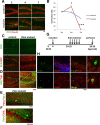Pten deletion in adult hippocampal neural stem/progenitor cells causes cellular abnormalities and alters neurogenesis
- PMID: 22539849
- PMCID: PMC6703621
- DOI: 10.1523/JNEUROSCI.5462-11.2012
Pten deletion in adult hippocampal neural stem/progenitor cells causes cellular abnormalities and alters neurogenesis
Abstract
Adult neurogenesis persists throughout life in restricted brain regions in mammals and is affected by various physiological and pathological conditions. The tumor suppressor gene Pten is involved in adult neurogenesis and is mutated in a subset of autism patients with macrocephaly; however, the link between the role of PTEN in adult neurogenesis and the etiology of autism has not been studied before. Moreover, the role of hippocampus, one of the brain regions where adult neurogenesis occurs, in development of autism is not clear. Here, we show that ablating Pten in adult neural stem cells in the subgranular zone of hippocampal dentate gyrus results in higher proliferation rate and accelerated differentiation of the stem/progenitor cells, leading to depletion of the neural stem cell pool and increased differentiation toward the astrocytic lineage at later stages. Pten-deleted stem/progenitor cells develop into hypertrophied neurons with abnormal polarity. Additionally, Pten mutant mice have macrocephaly and exhibit impairment in social interactions and seizure activity. Our data reveal a novel function for PTEN in adult hippocampal neurogenesis and indicate a role in the pathogenesis of abnormal social behaviors.
Figures









References
-
- Amaral DG. A Golgi study of cell types in the hilar region of the hippocampus in the rat. J Comp Neurol. 1978;182:851–914. - PubMed
-
- Backman SA, Stambolic V, Suzuki A, Haight J, Elia A, Pretorius J, Tsao MS, Shannon P, Bolon B, Ivy GO, Mak TW. Deletion of Pten in mouse brain causes seizures, ataxia and defects in soma size resembling Lhermitte-Duclos disease. Nat Genet. 2001;29:396–403. - PubMed
-
- Bauman ML, Kemper TL. Neuroanatomic observations of the brain in autism: a review and future directions. Int J Dev Neurosci. 2005;23:183–187. - PubMed
Publication types
MeSH terms
Substances
LinkOut - more resources
Full Text Sources
Other Literature Sources
Molecular Biology Databases
Research Materials
